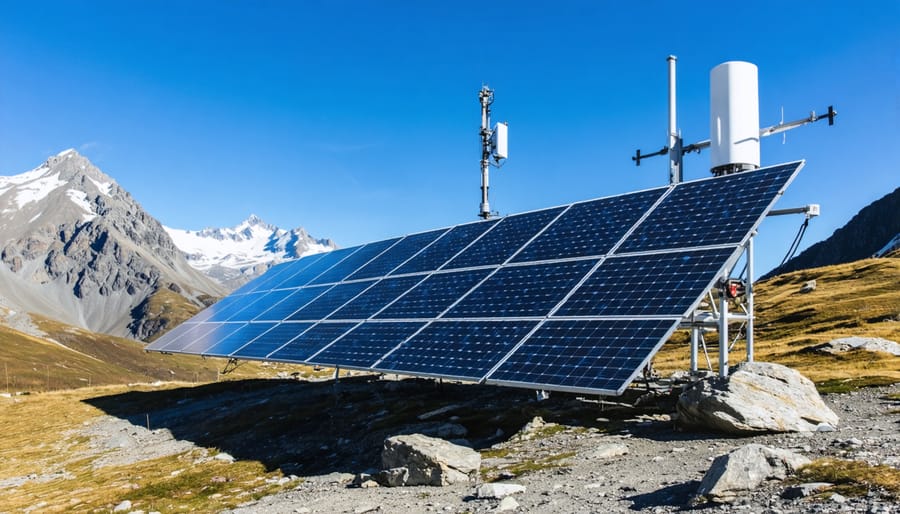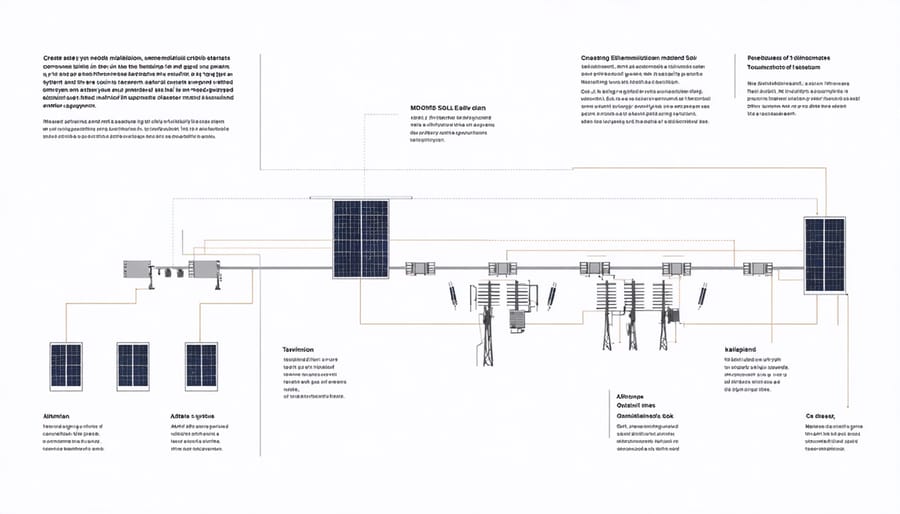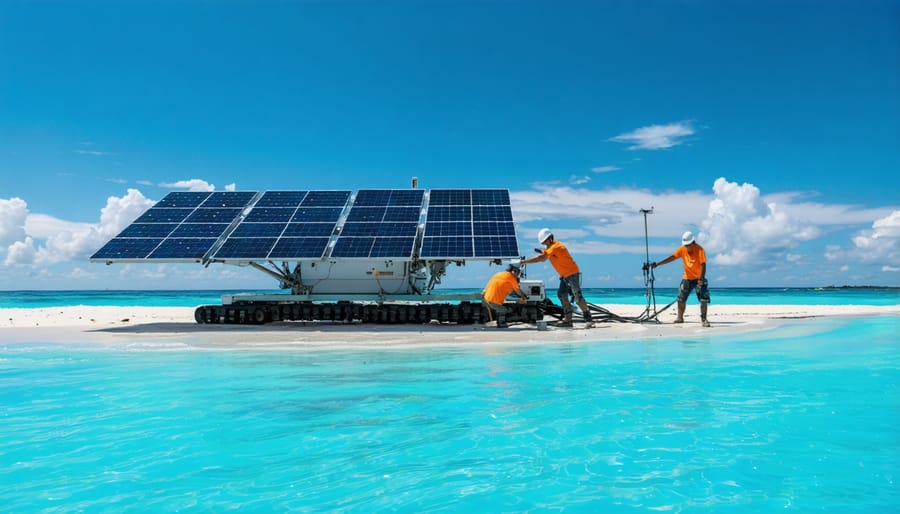Mobile Solar Power Brings Life-Changing Connectivity to Europe’s Remote Communities

Revolutionizing remote telecommunications infrastructure, modern off-grid solar solutions now deliver unprecedented mobility and reliability for mission-critical operations across Europe. Mobile solar power systems integrate cutting-edge photovoltaic technology with advanced energy storage capabilities, enabling rapid deployment in challenging environments while maintaining consistent power output for essential communications equipment.
These innovative systems have transformed how telecommunications companies approach remote installations, reducing operational costs by up to 60% compared to traditional diesel generators while eliminating carbon emissions. From emergency response networks in the Alps to remote cellular towers in rural Scandinavia, mobile solar power units provide sustainable energy independence without compromising performance.
European telecommunications providers are increasingly adopting these solutions to meet ambitious sustainability targets while ensuring network reliability. With plug-and-play functionality, sophisticated remote monitoring capabilities, and modular design principles, modern mobile solar installations offer a pragmatic path toward carbon-neutral telecommunications infrastructure – all while delivering the robust power requirements demanded by today’s advanced communication systems.
The Power of Mobile Solar Solutions for Remote Communications
Key Components of Mobile Solar Telecommunications Systems
Mobile solar telecommunications systems rely on three fundamental components working in harmony to ensure reliable, sustainable operations. At the heart of these systems are high-efficiency photovoltaic panels, typically monocrystalline or polycrystalline, specially selected for their durability and performance in varying weather conditions. These panels are mounted on adjustable frames that can be optimized for maximum solar exposure, with some advanced systems featuring automatic tracking capabilities.
The second crucial element comprises advanced solar power storage systems, usually utilizing lithium-ion or gel batteries, designed for deep-cycle operation and rapid charging capabilities. These storage solutions ensure continuous power supply during nighttime or cloudy conditions, typically dimensioned to provide 48-72 hours of autonomous operation.
The telecommunications equipment forms the third vital component, including transmission towers, antennae, and signal processing units. This equipment is specifically engineered for low power consumption while maintaining high reliability. Modern systems often incorporate smart power management controllers that optimize energy distribution between components, ensuring critical communications remain operational even during extended periods of limited solar exposure.
Integration of these components requires careful consideration of local climate conditions, service requirements, and accessibility needs. European installations often feature additional weather protection measures and remote monitoring capabilities, allowing operators to manage system performance from central locations. The modular nature of these systems enables quick deployment and scalability, making them ideal for both temporary installations and permanent infrastructure in remote locations.

Mobility Meets Reliability: Design Considerations
Creating reliable mobile solar power systems requires careful consideration of several key engineering challenges. The primary focus lies in balancing portability with power output capacity, ensuring systems remain lightweight while delivering sufficient energy for their intended applications.
Weight distribution and structural integrity form crucial aspects of the design process. Engineers must carefully select materials that offer durability without adding excessive bulk. Modern lightweight aluminium frames and high-efficiency solar panels help achieve this balance, while innovative folding mechanisms enable compact storage and easy transport.
Protection against environmental factors presents another significant challenge. Mobile solar installations must withstand various weather conditions, from intense heat to heavy rainfall. This necessitates robust weatherproofing solutions and the integration of protective features such as reinforced glass covers and sealed electrical components.
The efficiency of power conversion and storage systems plays a vital role in mobile applications. Advanced charge controllers and high-capacity lithium batteries optimise energy harvest and storage, while smart power management systems ensure steady output despite varying sunlight conditions.
Maintenance accessibility remains equally important. Designs must incorporate easy-access panels and modular components that facilitate quick repairs and replacements in the field. This approach minimises downtime and extends system longevity.
European manufacturers have made significant strides in addressing these challenges, developing solutions that meet strict quality standards while embracing sustainability principles. These innovations include smart tracking systems that maximise solar exposure and advanced thermal management solutions that maintain optimal operating temperatures.
By carefully considering these design elements, modern mobile solar power systems achieve the perfect balance between portability and reliable performance, making them suitable for diverse applications across various sectors.
Real-World Applications Across Europe
Alpine Communication Networks
The Swiss Alps present unique challenges for telecommunication infrastructure, making mobile solar power installations increasingly vital for reliable connectivity. A notable example is the Zermatt Valley installation, where a network of solar-powered communication relay stations maintains critical links between isolated mountain communities and emergency services.
These Alpine installations typically combine high-efficiency solar panels with advanced battery storage systems, designed to withstand extreme weather conditions including heavy snowfall and temperatures below -20°C. The systems are engineered with redundant power management capabilities and remote monitoring features, ensuring continuous operation throughout the year.
In Austria’s Tyrol region, mobile solar units power a network of emergency communication towers across ski resorts and hiking trails. These installations demonstrate remarkable resilience, with specially reinforced mounting systems that can withstand wind speeds of up to 200 km/h while maintaining optimal solar panel positioning.
Recent innovations include the integration of snow-shedding panel surfaces and automated cleaning systems, reducing maintenance requirements in hard-to-reach locations. The success of these installations has led to similar implementations across other European mountain ranges, including the Pyrenees and Italian Dolomites.
These projects showcase how mobile solar power can provide reliable energy solutions in challenging terrain while supporting critical communication infrastructure. The systems typically achieve 99.9% uptime, even during the darker winter months, thanks to careful capacity planning and energy storage optimization.

Island Communities Connected
Remote island communities across Europe are experiencing transformative changes through mobile-solar power installations. The Greek Aegean islands showcase remarkable success stories, where integrated solar solutions have revolutionized telecommunications and power accessibility. On Astypalea, a mobile-solar installation now powers the island’s main telecommunications tower, reducing diesel consumption by 85% while ensuring consistent connectivity for its 1,300 residents.
The Faroe Islands demonstrate how remote community solar benefits extend beyond basic power provision. Their hybrid solar-wind installation, featuring mobile units that can be relocated during extreme weather, maintains critical emergency communications while powering local businesses. This system has proven particularly valuable during winter months when traditional power sources face challenges.
Croatia’s Dalmatian archipelago presents another compelling example. Mobile-solar units deployed across multiple small islands have created an interconnected power network supporting both telecommunications and essential services. The installation on Vis Island now powers emergency services, internet connectivity, and local businesses, serving as a model for sustainable island development.
These implementations highlight how mobile-solar solutions adapt to unique geographical challenges while fostering community resilience. The systems’ mobility allows for optimal positioning throughout the year, ensuring maximum energy capture and stable communications infrastructure across diverse island terrains.

Installation and Maintenance Considerations
Successful implementation of mobile solar power systems requires careful planning and adherence to established remote solar integration techniques. Begin by conducting a thorough site assessment, considering factors such as solar exposure, terrain characteristics, and accessibility for maintenance crews. The mounting infrastructure must be robust yet portable, typically utilizing adjustable frames that can be secured on various surfaces while maintaining optimal panel angles.
Installation should prioritize quick deployment capabilities without compromising system stability. Essential components include rapid-connect wiring systems, weather-resistant junction boxes, and modular mounting brackets. For European installations, ensure all components meet IEC standards and local regulatory requirements for outdoor telecommunications equipment.
Regular maintenance is crucial for system longevity and optimal performance. Establish a quarterly inspection schedule focusing on:
– Panel surface cleaning to remove dust and debris
– Connection point integrity checks
– Battery system assessment and electrolyte levels (if applicable)
– Mounting structure stability verification
– Solar charge controller calibration
Weather monitoring systems should be integrated to automatically adjust panel positioning and protect equipment during severe conditions. Implement remote monitoring capabilities to track system performance and enable predictive maintenance scheduling.
For winter operations in northern European regions, consider installing self-cleaning mechanisms and heating elements to prevent snow accumulation. Cable management systems should incorporate flexible conduits that withstand repeated movement while protecting against environmental factors.
Documentation of installation procedures and maintenance protocols is essential for consistent system performance. Train local maintenance teams on troubleshooting procedures and emergency response protocols. Establish clear communication channels with equipment suppliers and technical support services to ensure rapid resolution of any issues that arise during operation.
Mobile solar power has revolutionized telecommunications infrastructure in remote European locations, enabling reliable connectivity while advancing sustainability goals. The integration of efficient solar panels, advanced battery storage, and smart monitoring systems has created a robust foundation for off-grid communications. This technology continues to evolve, with innovations in photovoltaic efficiency and energy storage promising even greater capabilities for remote installations. Looking ahead, the expansion of mobile solar solutions will play a crucial role in bridging the digital divide, supporting emergency communications, and facilitating the growth of IoT networks across Europe. As costs decrease and technology improves, we can expect to see wider adoption of these systems, particularly in areas where traditional power infrastructure remains challenging to implement or maintain.
Leave a Reply